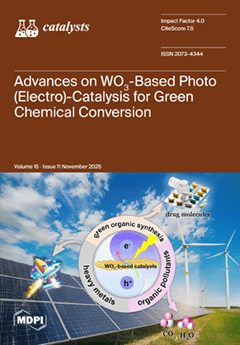With the acceleration of industrialization, the demand for NO
x abatement is becoming increasingly urgent. Finding safer and more stable reducing agent replacements and efficient catalysts is crucial for selective catalytic reduction (SCR) industrial NO
x abatement. Low-temperature hydrocarbon-assisted NO
x reduction (HC-SCR) remains attractive for industrial abatement. A series of industrial-grade TiO
2 support catalysts modified with a bimetallic MnCe active component, represented as TiO
2-ig, was prepared by the impregnation method to test the NO conversion performance under a 200–400 °C window with C
3H
6 as a reducing agent, and the physical properties were characterized using the BET and XRF methods. Under the feed of 150 ppm NO, 150 ppm C
3H
6, and 3%O
2—the optimal composition—Mn
15Ce
10/TiO
2-ig catalyst exhibited the highest NO
x conversion of 77.3% among industrial-grade TiO
2 support catalysts, with the corresponding temperature reduced to 275 °C. Furthermore, a slight improvement in catalytic activity was observed upon changing the TiO
2 support type. The industrial-grade and nano-sized TiO
2 supports predominantly exhibited mesoporous structures, while the anatase TiO
2 support contained a greater proportion of macropores. A steady-state kinetic model constructed for Mn
15Ce
10/TiO
2-ig catalyst indicates that the NO reaction rate is independent of C
3H
6 and O
2 concentrations at 200 and 250 °C. At 300 °C, C
3H
6 inhibits the reaction, while both O
2 and NO promote it. Changes in activation energy and the pre-exponential factor suggest a mechanistic shift from adsorption-limited at lower temperatures to reaction-limited at higher temperatures. Overall, using industrial-grade TiO
2 with MnCe promoters delivers meaningful NO
x reduction in a low-temperature regime and provides kinetic insights relevant to process design for industrial C
3H
6-SCR.
Full article





